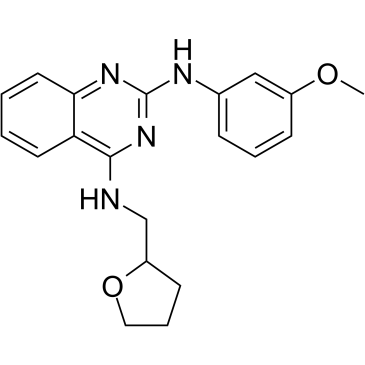| In Vitro: |
LCH-7749944 (GNF-PF-2356; 5-50 μM; 24 hours) inhibits the proliferation of MKN-1, BGC823, SGC7901 and MGC803 cells in a concentration dependent manner[1]. LCH-7749944 (5-20 μM; 12-48 hours) induces apoptosis of SGC7901 cells[1]. LCH-7749944 (5-20 μM; 12-48 hours) prominently induces a dose-dependent increase in the percentage of cells in G1 phase and decrease in S phase[1]. LCH-7749944 (5-30 μM; 24 hours) dramatically decreases levels of phosphoPAK4, phospho-c-Src, phospho-EGFR and cyclin D1 protein expression in a dose-dependent manner[1]. Cell Proliferation Assay[1] Cell Line: MKN-1, BGC823, SGC7901 and MGC803 human gastric cancer cells Concentration: 5, 10, 15, 20, 25, 30, 35, 40, 45, 50 μM Incubation Time: 24 hours Result: Inhibited the proliferation of MKN-1, BGC823, SGC7901 and MGC803 cells in a concentration dependent manner. Apoptosis Analysis[1] Cell Line: SGC7901 cells Concentration: 5, 10, 20 μM Incubation Time: 12, 24, 48 hours Result: Induced apoptosis of SGC7901 cells. Cell Cycle Analysis[1] Cell Line: SGC7901 cells Concentration: 5, 10, 20 μM Incubation Time: 12, 24, 48 hours Result: Prominently induced a dose-dependent increase in the percentage of cells in G1 phase and decrease in S phase. Western Blot Analysis[1] Cell Line: SGC7901 cells Concentration: 5, 10, 20, 30 μM Incubation Time: 24 hours Result: Dramatically decreased levels of phosphoPAK4, phospho-c-Src, phospho-EGFR and cyclin D1 protein expression in a dose-dependent manner. |

 To enhance service speed and avoid tariff delays, we've opened a US warehouse. All US orders ship directly from our US facility.
To enhance service speed and avoid tariff delays, we've opened a US warehouse. All US orders ship directly from our US facility.




















